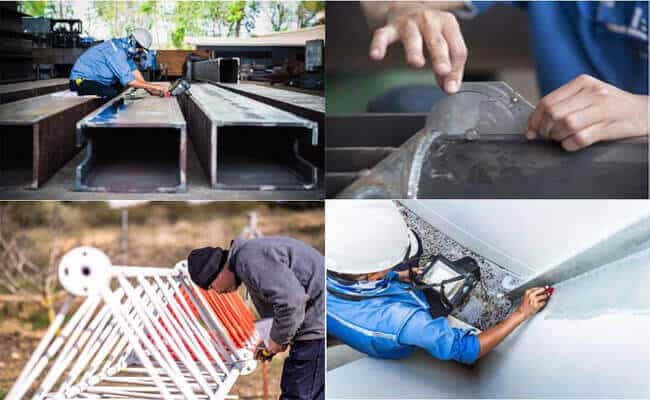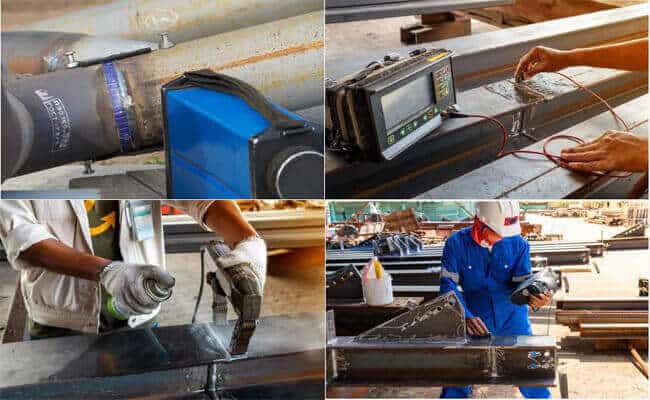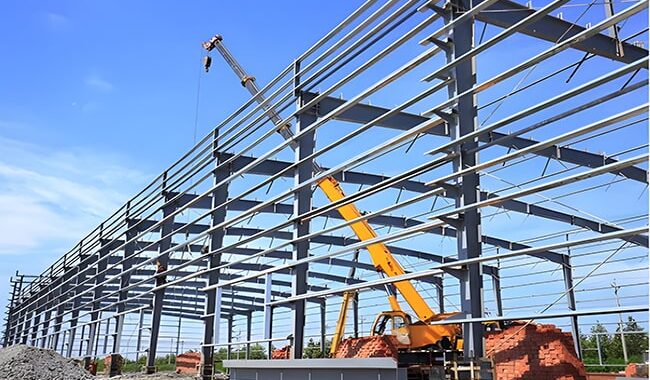In the construction of modern storage facilities, steel structure warehouses have become one of the mainstream building forms due to…
Steel structure inspection includes all tests and inspections of steel structure raw materials, welding consumables, weldments, fasteners, welds, coatings, and other materials.
In the inspection of steel structures, it is necessary to check the size and flatness of components, surface defects, the connection between components, the detection of welding and bolt connections, the corrosion detection of steel, and the detection of the thickness of the fireproof coating. Suppose the steel does not have a certificate of conformity when it leaves the factory, or there is doubt about its quality. In that case, it is necessary to increase the mechanical performance test of the steel, and its chemical composition needs to be tested when necessary.

FAQs on steel structure inspection
1. What is a steel structure inspection?
It is a process of evaluating the condition and integrity of a steel structure to ensure it meets safety standards and to identify any potential problems.
2. Why is a steel structure inspection important?
Inspections are important to maintain the structural stability and safety of a building. It can prevent collapses, accidents, and structural failures.
3. What are the common inspection methods for steel structures?
Visual inspection, ultrasonic testing, magnetic particle inspection, dye penetrant inspection, and radiographic testing are common methods used for steel structure inspections.
4. How often should a steel structure be inspected?
The frequency of inspection depends on various factors, such as the type of structure, usage, and environmental conditions. It is recommended to have regular inspections as per industry standards and regulations.
5. Who can perform a steel structure inspection?
Steel structure inspections should be performed by trained and qualified inspectors who have experience in the field.
6. What are the key areas to inspect in a steel structure?
The key areas to inspect include the connection points, joints, welds, bolts, gusset plates, and any areas prone to corrosion or damage.
7. What happens if a steel structure fails inspection?
If a steel structure fails inspection, it means that it does not meet safety standards and may pose a risk to the public. Repairs or replacements may be necessary to bring the structure up to code.
Steel Structure Inspection for Measurement
The measurement of steel structure includes the following aspects: primary structure engineering inspection, sampling inspection, steel chemical composition analysis, paint inspection, construction engineering materials, waterproof material inspection, etc. energy-saving inspection, and other complete inspection technologies.
Steel structure inspection for size and flatness
For the size inspection of steel structure, three places are mainly used for measurement, and the average value is used as the representative value of the size. The size deviation of steel members should be based on the size specified in the design drawings, and the allowable value of the deviation should meet the specification requirements. The deformation of steel beams and steel truss members includes vertical deformation in the plane and lateral deformation outside the plane. Therefore, it is necessary to detect the straightness of the two directions. The deformation of the steel column mainly includes the tilt and twist of the column body. The detection method can be visual inspection first. If you find a problem, you need to tighten an iron or a thin wire between the beam and the truss fulcrum and then measure the brix and deviation at each point. The inclination of the steel column can be measured with theodolite or plumb weight, and the distortion of the column can be measured in an iron wire, or a thin wire stretched between the steel member’s fulcrums to measure.
Steel structure inspection for connections
If there is a connection plate, it is necessary to check whether the size and thickness of the connection plate meet the requirements. You can use a ruler to check the flatness, measure bolt holes, etc., detect cracks, local defects, etc.
The connection of bolts can be detected by combining visual inspection and hammering, and the tightness of the bolts can be rechecked with a wrench, especially the connection of high-strength bolts should be carefully checked. For the number, diameter, and arrangement of bolts need to check.
The inspection of welded joints can be carried out by ultrasonic flaw detector or ray detector, and the appearance quality inspection should be carried out when the internal defects of the weld are detected.
Corrosion detection:
Steel is easy to rust in a humid environment. After corrosion, the steel cross-section will weaken, and the bearing capacity will decrease. Thickness gauges and vernier calipers can be used for measurement.
Inspection of fire protection coating:
The width of cracks on the surface of the fireproof coating should not be greater than 0.5mm, and the thickness of the coating should meet the design requirements of the fire resistance limit. Design requirements and the thickness of the thin part should not be less than 85% of the design requirements.

Non-destructive testing (NDT)
NDT uses the characteristics of sound, light, magnetism, and electricity to detect defects or inhomogeneities on the premise of not damaging or affecting the performance of steel components and to give the size of the defects. The general term for all technical means to determine the technical state of the steel structure (such as qualified or not, remaining life, etc.) based on information such as location, nature, and quantity.
According to the material, structure, manufacturing method, working medium, service conditions, and failure mode of the inspected part, the type, shape, location, and direction of the defect that may occur are expected. An appropriate non-destructive testing method is selected.
Conventional non-destructive testing methods :
Ultrasonic Testing (abbreviated UT);
Radiographic Testing (abbreviated RT);
Magnetic particle testing (abbreviated MT);
Penetrant Testing (abbreviated PT);
1. Radiation detection
Radiographic inspection is a technology that uses the intensity attenuation of rays (X-rays, γ-rays, neutron rays, etc.) to pass through materials or workpieces to detect discontinuities in their internal structures. When the rays pass through the material or workpiece, due to their different intensities, they have different degrees of sensitivity on the photosensitive film, thereby generating internal discontinuous images.
Radiographic testing is mainly used in the detection of internal defects of metals, non-metals, and their workpieces, and the detection results are highly accurate and reliable. The film can be stored for a long time, has good traceability, and can quickly determine the defect’s nature and plane position.
Radiographic detection also has its shortcomings; it is difficult to determine the burial depth of defects in materials and workpieces; for linear defects (such as vertical cracks, penetrating pores, etc.) perpendicular to the surface of materials and workpieces, it is easy to miss or misjudge; Radiation detection requires strict protection measures to prevent radiation from harming the human body; the detection equipment is complex and costly.
Radiographic inspection is only suitable for the plane inspection of materials and workpieces, and it is helpless for inspecting special-shaped parts, T-shaped welds, fillet welds, etc.
2. Ultrasonic testing
Ultrasonic testing uses ultrasonic waves to propagate in metal and non-metallic materials and their workpieces. The acoustic properties of materials (workpieces) and changes in the internal organization have a specific impact on the propagation of ultrasonic waves. Detecting the degree and status of ultrasonic waves affected Techniques for changing the properties and structure of materials (workpieces).
Ultrasonic testing, like radiographic testing, is mainly used to detect internal defects in materials (workpieces). The detection sensitivity is high, the operation is convenient, the detection speed is fast, the cost is low, and there is no harm to the human body. However, ultrasonic detection cannot determine the nature of the defect; there is no original record of the detection results, and the traceability is poor.
Ultrasonic testing also has incomparable advantages over radiographic testing. It can detect complex components such as special-shaped components, fillet welds, and T-shaped welds; at the same time, it can also detect the burial depth of defects in materials (workpieces).
3. Magnetic particle testing
Magnetic particle testing uses magnetic flux leakage and a suitable testing medium to find discontinuities on and near a material’s surface (workpiece).
As a surface inspection, magnetic particle inspection has the characteristics of flexible operation and low cost. However, magnetic particle inspection can only be applied to detect surface or near-surface defects of ferromagnetic materials and workpieces (carbon steel, ordinary alloy steel, etc.). (such as stainless steel, copper, etc.) defects can not be detected.
Magnetic particle testing is the same as ultrasonic testing. There is no original record of the test results and poor traceability. It cannot detect deep defects in materials and workpieces, but the shape of materials and workpieces does not limit it.
4. Penetration testing
Penetration testing is a detection method that utilizes the capillary action of liquid to infiltrate the penetrating liquid into solid materials and open defects on the surface of the workpiece and then suck out the penetrating liquid penetrated by the imaging agent to the surface to display the existence of defects.
Penetrant inspection is simple in operation, low in cost, and takes a long time in the inspection process. However, it can only detect the penetration of materials and workpieces and surface opening defects and cannot detect defects that only exist in the interior.
5. Time Of Flight Diffraction(TOFD) detection
The principle of TOFD is that when the ultrasonic wave encounters a defect such as a crack, a diffracted wave superimposed on the usually reflected wave will occur at the tip of the defect. The probe detects the diffracted wave, and the size and depth of the defect can be determined. When the ultrasonic wave has a propagation obstacle at a linear discontinuity with a defect, such as a crack, diffraction will occur at the end of the crack in addition to the customarily reflected wave. Diffraction energy is emitted over a wide range of angles, which is assumed to originate at the crack tip. This is in marked contrast to conventional ultrasound, which relies on summing intermittently reflected energy.
According to the theory and characteristics of TOFD, it has excellent advantages in detecting the back wall container. In the initial stage of domestic use, we should give full play to its advantages and use other technologies to compensate for its shortcomings so that TOFD technology can be applied to detection faster. (A type of ultrasonic testing, the new development direction of the non-destructive testing research department)
Steel structure performance for performance
Steel Mechanics Testing
Test the mechanical properties of the steel used in steel structures, such as tensile, bending, impact, hardness, etc.
Mechanical testing of fasteners
Test the mechanical properties of fasteners used in steel structures, such as anti-slip coefficient, axial force, etc.
Metallographic analysis
Conduct metallographic analysis on the steel used in the steel structure, such as microstructure analysis, microhardness test, etc.
Chemical composition
Analyze the chemical composition of the steel used in the steel structure.
Stress test
Test and monitor the stress changes of key parts during the installation and unloading of steel structures.
The above items include steel structure mechanical performance testing (tensile, bending, impact, hardness), steel structure fastener mechanical performance testing (anti-slip coefficient, axial force), steel structure metallographic testing and analysis (microstructure analysis, Microhardness test), steel structure chemical composition analysis, steel structure non-destructive testing, steel structure stress testing, and monitoring, paint testing, salt spray test and other complete sets of testing technologies are called steel structure inspection technology.














